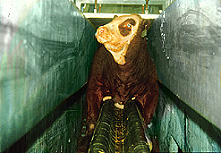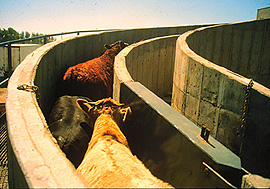Providing Less Stressful Pre-Slaughter Handling
 Ron Kilgour from New Zealand was the first researcher to discuss that
there was a need for greater emphasis on procedures that occur prior to
stunning or slaughter (Kilgour, 1978).
Ron Kilgour from New Zealand was the first researcher to discuss that
there was a need for greater emphasis on procedures that occur prior to
stunning or slaughter (Kilgour, 1978).

Cattle and sheep will move quietly through single file
races and
ride quietly in a well designed conveyor restrainer system. Moving in
single file is a natural behaviour for cattle. In the U.S., large stunning
boxes which held more than one bovine have been replaced with conveyor
restrainers.


Center track double rail restrainer. This system is available for both
sheep and cattle. Livestock are riding the conveyor in a comfortable,
upright position. This is a very humane method of restraint.
- The V conveyor restrainer was introduced for cattle in the
1970s (Schmidt, 1972; Willems and Markley, 1972). It was replaced in
the l990's with the center track double rail restrainer (Giger et al., 1977;
Grandin, 1988b; 1991). Cattle and sheep will remain calm in conveyors
because they are touching the animal in front and back of them.
- V
conveyors work well for round, fat pigs, but less well for lean pigs. The
author has observed that slender,
lean pigs are not supported properly and heavily muscled pigs are pinched
on the hams, whereas round, fat pigs are held in a comfortable position.
Lean pigs are properly supported on a center track restrainer.
- In England, head restraint devices are required by legislation to
hold a bovine's head for captive bolt stunning. The purpose of the
legislation was to improve stunning accuracy. In some circumstances,
head restraint can increase stress. Ewbank et al. (1992) found that cortisol
levels were higher in a head restraint compared to a conventional single
animal stunning box. It took an average of 32 seconds to induce the cattle
to put their heads in the poorly designed yoke used in this study.
- Stress
can be minimal in a well designed head restraint where the animal is
stunned immediately after the head is caught (Tume and Shaw,1992; Frank
Shaw, personal communication). The author has observed electrical stunning
of cattle in a head restraint in New Zealand. Each animal quietly entered
the stunning box and was stunned within 2 seconds after the head was
clamped. Information on the design of head restraint devices can be
found in CSIRO (1989) and Grandin (1993; 1994).
- Stress caused by
prolonged
restraint will be a severe problem if live animals are subjected to
intravenous injections shortly prior to slaughter. Payne and Young (1995)
report that intravenous injections of lambs with antifreeze glycoproteins
may improve the quality of frozen meat.
 Design mistakes in races and
forcing pens will cause stress.
Design mistakes in races and
forcing pens will cause stress.
One of the most serious design mistakes is laying the race out so that its
entrance appears to be a dead end. Cattle will move more easily through a
curved race compared to a straight race, but it must be laid out
correctly (Grandin, 1980; 1990; 1993).

Aerial view of a curved system for handling and loading
cattle.
Practical experience has shown that
an animal standing in the forcing pen must be able to see a minimum of
two to three body lengths up the single file race before it curves.
Bending the single file race too sharply where it joins the forcing pen
will cause animals to balk.

Cattle move more easily through a curved ramp.

References :
 Grandin, T. (Editor) 1993
Livestock Handling and
Transport. CAB
International,
Grandin, T. (Editor) 1993
Livestock Handling and
Transport. CAB
International,
Wallingford Oxon, United Kingdom
 Click here to return to the Homepage for more information on animal behavior, welfare, and care.
Click here to return to the Homepage for more information on animal behavior, welfare, and care.
 Ron Kilgour from New Zealand was the first researcher to discuss that
there was a need for greater emphasis on procedures that occur prior to
stunning or slaughter (Kilgour, 1978).
Ron Kilgour from New Zealand was the first researcher to discuss that
there was a need for greater emphasis on procedures that occur prior to
stunning or slaughter (Kilgour, 1978). Ron Kilgour from New Zealand was the first researcher to discuss that
there was a need for greater emphasis on procedures that occur prior to
stunning or slaughter (Kilgour, 1978).
Ron Kilgour from New Zealand was the first researcher to discuss that
there was a need for greater emphasis on procedures that occur prior to
stunning or slaughter (Kilgour, 1978).


 Design mistakes in races and
forcing pens will cause stress.
Design mistakes in races and
forcing pens will cause stress.



Grandin, T. (Editor) 1993
 Click here to return to the Homepage for more information on animal behavior, welfare, and care.
Click here to return to the Homepage for more information on animal behavior, welfare, and care.